Bhojpur, Madhya Pradesh
| Bhojpur | |
|---|---|
| town | |
|
The temple at Bhojpur | |
 Bhojpur Location in Madhya Pradesh, India | |
| Coordinates: 23°6′54″N 77°35′43″E / 23.11500°N 77.59528°ECoordinates: 23°6′54″N 77°35′43″E / 23.11500°N 77.59528°E | |
| Country | India |
| State | Madhya Pradesh |
| Languages | |
| • Official | Hindi |
| Time zone | IST (UTC+5:30) |
Bhojpur is a town of historical and religious importance in Raisen District of Madhya Pradesh, India.
Geography and hydrology
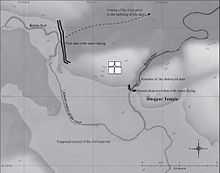
Bhojpur is situated on the Betwā River, 28 km from Bhopal, the state capital of Madhya Pradesh. The site is located on sandstone ridges typical of central India, next to a deep gorge through which the Betwā River flows. Two large dams, constructed of massive hammer-dressed stones, were built in the eleventh century to divert and block the Betwā, so creating a large lake. The approximate size of the lake is shown in the site plan given here.
History
Bhojpur takes its name from king Bhoja (reg. c. 1000–1055 CE), the most celebrated ruler of the Paramāra dynasty.[1] There is no archaeological evidence from Bhojpur before the eleventh century, a fact confirmed by local legends which recount how Bhoja made a vow to build a series of dams “to arrest the streams of nine rivers and ninety-nine rivulets”. A location was found in the kingdom that allowed the king to fulfil this vow and the dams were duly built at Bhojpur.[2]
Although the dams were constructed of cyclopean masonry, one of them was opened on the orders of Hoshang Shah of Malwa in the fifteenth century. According to Persian chronicles, he ordered the dam to be broken at the request of local merchants in Bhopal and Vidisha whose caravans were being raided by bandits taking refuge at an inaccessible spot protected by the lake.[3]
Places of historical, archaeological and religious interest
Bhojeśvar or Bhojasvāmin temple
Bhojpur is famous for the incomplete Bhojeśvar temple dedicated to Shiva. The temple houses one of the largest liṅga-s in India, 5.5 m (7.5 ft) tall and 2.3 m (18 ft) in circumference. It is crafted out a single rock.[4] The building is under the protection of the Archaeological Survey of India.
The attribution of the temple to Bhoja is based on the testimony of Merutuṅga, who reports in the Prabandhacintāmaṇi that Bhoja bestowed on the poet Māgha “all the merit of the new Bhojasvāmin temple that he was about to build himself”, and then “set out for the country of Mālava”.[5] The style of the sculpture on the building confirms an early to mid-eleventh-century date for the structure.
The building as it stands consists of the inner cella or garbhagṛha, supported by massive pillars, surmounted with an elegant corbelled dome. The outer walls and superstructure of the temple were never built.
Quarries and rock drawings
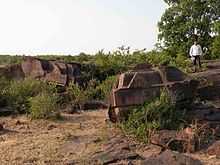
The temple at Bhojpur is unique in being left unfinished, with a series of large architectural parts still located in the quarries where the stones were cut and fashioned. In addition, there are a significant number of architectural drawings engraved on the flat surfaces of the quarry showing mouldings, pillars, and temple plans.[6] Also of note is the large earthen ramp behind the temple which shows how medieval craftsmen raised the large blocks of stone into position.
Cave of Pārvatī
Immediately opposite the temple, on the west side of the gorge facing the Betwā, is a rock-shelter or cave, now occupied by religious mendicants. Popularly known as Pārvatī's Cave, the cave contains a number of sculptures and architectural fragments dating to the eleventh century.
Remains of Bhoja's Royal Palace
On the low plateau above the Cave of Pārvatī and opposite the Bhojpur temple are the remains of Bhoja's palace. Only the foundations survive. The complex is laid out as a grid in a square, with a courtyard in the centre (see site plan above). It is oriented on an exact north-south axis as prescribed in the Samarāṅganasūtradhāra, an architectural treatise ascribed to Bhoja.[7] Among the many features of interest are unfinished carved blocks and graffiti engraved on the rock floor. The latter includes diagrams for games and a series of names dating to the eleventh century and later. The palace is a unique survival, being the only medieval building of its kind in northern India. Its association with Bhoja and its close conformity to a text ascribed to the king mark it out as a site of national and international cultural importance. The site of the palace, like the neighbouring dams, is unprotected. The remains of the palace are being slowly destroyed as local people collect stones for modern building purposes.
Jain temples
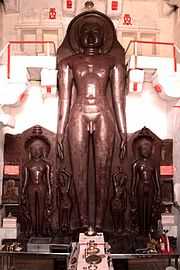
Bhojpur also has an unfinished Jain temple containing a 6-meter-tall statue of BhagwanShantinath and two statues of Bhagwan Parshvanath (left) and Bhagwan Suparasnath (right). On the base of one of the images is an inscription mentioning king Bhoja, the only epigraphic evidence connecting Bhoja to the site.[8] The same temple complex hosts shrine for Ācārya Mantunga who wrote Bhaktamara Stotra.
Cultural activities and festivals
Every year, on the occasion of Maha Shivaratri, a big mela is organized at Bhojpur.[9]
Bhoja's legacy at Bhojpur
Today, the partly ruined and incomplete Bhojeśvar temple still humbles the mind. Constructed in the latter part of the 11th century, its great stone blocks encompass a door frame, which towers ten meters high and five meters wide. Four titanic pillars, richly carved, rise to support an incomplete dome. The high noon sun lances through the dome, illuminates a massive pedestal made of three stepped blocks of sandstone, seven meters square. An iron ladder ascends this huge pedestal to reach the uppermost platform, directly beneath the high roof, open to the sky. Dominating this platform and the great brooding temple is a magnificent lingam more than five meters high and over two meters in circumference.
In the temple, religion and architecture, sculpture, drama and a weird vision combine in a compelling assertion of reality. There is a brooding imminence about this great black temple that demands attention and reverence; and streams of school girls, as bright as moving garlands of flowers, moved up and down the ladder seeking the blessings of the great monolith, bowing to mumbled prayers from an ochre-robed, white-bearded priest who stood near like a vision of a benevolent and slightly portly Father Time.
If the incomplete temple can evoke such awe, how much reverential fear would have been evoked by the final work of Raja Bhoja? But the savant king was fated never to complete his imposing shrine. For, at the glorious end of the Paramara era in 1060, the Chalukyas of Kalyani and Gujarat combined with Lakshmi-Karna of the Kalachuri dynasty attacked Raja Bhoja's capital. In that fierce battle, Raja Bhoja died defending his kingdom. And so today, only the temple stands, and beyond it, a damaged Jain colossus rides in a whitewashed building. Stones still lie around partially carved as they had been when the sculptors fled nine centuries ago when Bhoja fell. Eagles still wheel in the wide sky as they did over that ancient bloody battlefield. And a train chuffs and mourns across the plain like a sad spirit of a warrior, slowly departing.
But Bhoja's forty-two-year reign is still celebrated in myth and legend as well as in this time-defying monument. For, as long as the temple stands, and the doorway towers and the sculptures enchant and the great lingam broods with implacable power in the 900-year-old Bhojeshwar, so long will the memory of King Bhoja shine like a diadem.
Gallery
-
History of Shiva Temple
-
Shiva Temple
-
Front view
-
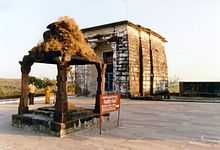
Mantunga Acharya Shrine
-

-

-

-
River Betwa close to the Bhojeshwar temple at Bhojpur
-
Graffiti near the palace remains at Bhojpur
-
Ruins of the walls of Bhoja's palace at Bhojpur
-
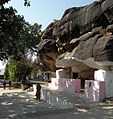
Rock shelter at Bhojpur popularly known as Pārvatī's Cave
-

Interior of the temple dome at Bhojpur, before conservation
-
Earthen ramp behind the temple at Bhojpur
-
Satī pillar beside the Bhojpur temple, probably 18th century.
-
Stone mining activity at the palace site in 2012
References
| Wikimedia Commons has media related to Bhojpur. |
- ↑ Arvind K. Singh, "Interpreting the History of the Paramāras," Journal of the Royal Asiatic Society 3, 22, 1 (2012), pp. 13–28. Online version: http://journals.cambridge.org/action/displayJournal?jid=JRA
- ↑ John Malcolm, Report on the Province of Malwa, and adjoining Districts (Calcutta, 1822), p. 19.
- ↑ U. P. Day, Medieval Malwa: a Political and Cultural History, 1401–1562. (Delhi, 1965): appendix.
- ↑ Bhojpur name="unfinished_dream">Unfinished dream
- ↑ Cited in M. Willis, "Dhār, Bhoja and Sarasvatī: from Indology to Political Mythology and Back," Journal of the Royal Asiatic Society 22, 1 (2012), p. 130. Online version: http://journals.cambridge.org/action/displayIssue?decade=2010&jid=JRA&seriesId=3&volumeId=22&issueId=01&iid=8509262.
- ↑ K. K. Chakravarty, Bhojpur Temple, a vision of harmony (Bhopal, 1991)
- ↑ Mattia Salvini, "The Samarāṅganasūtradhāra: Themes and Context for the Science of Vāstu," Journal of the Royal Asiatic Society 22, 1 (2012), pp. 35–55. Online version: http://journals.cambridge.org/action/displayJournal?jid=JRA.
- ↑ D. C. Sircar, “Three Paramara Inscriptions”, Epigraphica Indica 35 (1963–64), p. 186; H. V. Trivedi, Inscriptions of the Paramāras, 2, pp. 60–61.
- ↑ Place of Interest: Bhojpur
- Law, Bimala Churn (1926). "5. The Bhojas". Ancient Indian Tribes. Motilal Banarsidas.
| ||||||||||||||||||||||||||||||
(sandeep mishra)








